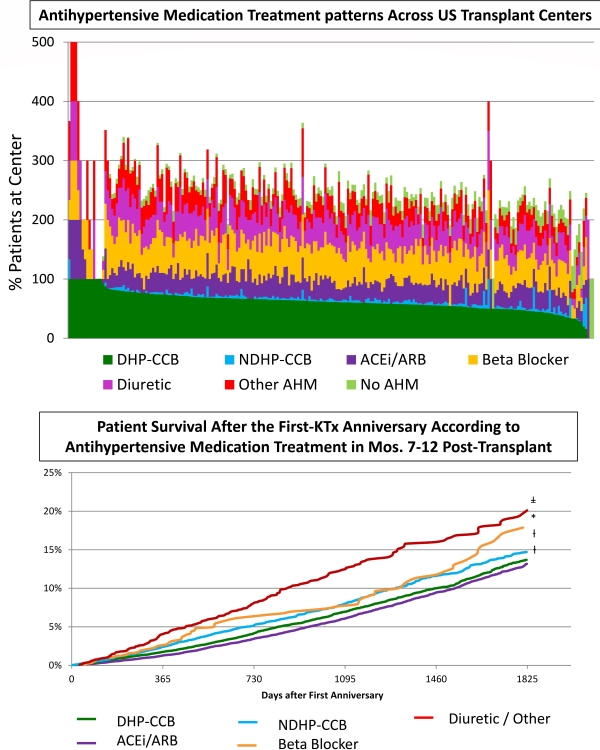Antihypertensive Medication Use after Kidney Transplant: Practice Variation and Clinical Outcomes
H. Yamout,1,2 R. Ouseph,1 M. Schnitzler,1 H. Xiao,1 V. Dharnidharka,3 A. Naik,4 N. Lam,5 F. Koraishy,1,2 H. Randall,1 D. Brennan,6 D. Segev,6 B. Kasiske,7 G. Hess,8 K. Lentine.1
1Saint Louis Univ, St. Louis
2St. Louis VA, St. Louis
3Washington Univ, St. Louis
4Univ Michigan, Ann Arbor, Canada
5Univ Alberta, Edmonton
6Johns Hopkins, Baltimore
7Hennepin County, Minneapolis
8Symphony Health, Conshohocken.
Meeting: 2018 American Transplant Congress
Abstract number: 337
Keywords: Hypertension, Kidney transplantation, Mortality, Multivariate analysis
Session Information
Session Name: Concurrent Session: Kidney: Cardiovascular and Metabolic - 2
Session Type: Concurrent Session
Date: Monday, June 4, 2018
Session Time: 4:30pm-6:00pm
 Presentation Time: 4:30pm-4:42pm
Presentation Time: 4:30pm-4:42pm
Location: Room 303
Hypertension is common among kidney transplant (KTx) recipients, but the impact of antihypertensive medication (AHM) choice on patient and graft outcomes is not well defined.
We examined a novel database linking SRTR registry data for 54,153 KTx recipients with AHM fill records from a large pharmaceutical claims warehouse (2008-2015). Mutually exclusive regimens were defined hierarchically as based in: Angiotensin converting enzyme inhibitor/angiotensin receptor blockers (ACEi/ARB), dihydropyridine calcium channel blockers (DHP-CCB), non-DHP (NDHP)-CCB, beta blockers or vasodilators/others. Associations (adjusted hazard ratio, 95% LCL aHR 95% UCL) of AHM regimen in mos 7-12 post-KTx with patient and graft survival over the next 5 yrs were quantified by multivariate Cox regression including adjustment for recipient, donor and transplant factors, and clustering for center.
The most common AHM after transplant were DHP-CCB, followed by beta-blockers, ACEi/ARB, and diuretics, but regimen patterns varied across transplant centers (Fig 1). In bi-level hierarchical modeling, compared to DHP-CCB-based treatment, ACEi/ARB use was more common in those with diabetes, obesity, and on mTORi-based immunosuppression. Unadjusted survival varied with AHM treatment (Fig 2). Compared to DHP-CCB regimen, adjusted mortality was higher in those managed with NDHP-CCB (aHR 1.111.241.37) and 'other' agents (aHR 1.441.692.00), but lower in patients treated with ACEi/ARB (aHR 0.850.920.99).
While associations may in part reflect unobserved selection factors, these data motivate the need for controlled studies to determine optimal AHM regimens after KTx, reduce unjustified practice variation, and inform evidence-based best practices.
CITATION INFORMATION: Yamout H., Ouseph R., Schnitzler M., Xiao H., Dharnidharka V., Naik A., Lam N., Koraishy F., Randall H., Brennan D., Segev D., Kasiske B., Hess G., Lentine K. Antihypertensive Medication Use after Kidney Transplant: Practice Variation and Clinical Outcomes Am J Transplant. 2017;17 (suppl 3).
To cite this abstract in AMA style:
Yamout H, Ouseph R, Schnitzler M, Xiao H, Dharnidharka V, Naik A, Lam N, Koraishy F, Randall H, Brennan D, Segev D, Kasiske B, Hess G, Lentine K. Antihypertensive Medication Use after Kidney Transplant: Practice Variation and Clinical Outcomes [abstract]. https://atcmeetingabstracts.com/abstract/antihypertensive-medication-use-after-kidney-transplant-practice-variation-and-clinical-outcomes/. Accessed December 14, 2025.« Back to 2018 American Transplant Congress

